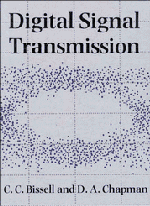Book contents
- Frontmatter
- Contents
- Preface
- 1 Introduction
- PART 1 MODELS
- PART 2 PROCESSES
- 4 Pulses for digital transmission
- 5 Line codes
- 6 Channel codes
- PART 3 DIGITAL TRANSMISSION OVER THE PUBLIC SWITCHED TELEPHONE NETWORK
- Appendix A Fourier series and transforms
- Appendix B Convolution
- Appendix C Modelling applications of spreadsheets
- Answers to numerical exercises
- References
- Index
4 - Pulses for digital transmission
from PART 2 - PROCESSES
Published online by Cambridge University Press: 05 June 2012
- Frontmatter
- Contents
- Preface
- 1 Introduction
- PART 1 MODELS
- PART 2 PROCESSES
- 4 Pulses for digital transmission
- 5 Line codes
- 6 Channel codes
- PART 3 DIGITAL TRANSMISSION OVER THE PUBLIC SWITCHED TELEPHONE NETWORK
- Appendix A Fourier series and transforms
- Appendix B Convolution
- Appendix C Modelling applications of spreadsheets
- Answers to numerical exercises
- References
- Index
Summary
Introduction
Armed with the general modelling framework developed in Part 1, and the layer model just presented in the Introduction to Part 2, we now turn specifically to the transmission of digital pulses. We begin with baseband digital signals – that is, with signals whose spectrum extends down to or near zero frequency. For much of the discussion the model of a transmission link shown in Fig. 4.1 will be used, in which a transmitted pulse is viewed as the impulse response of a suitable transmit filter GT(f). This idea was first introduced in Section 2.5. Although it does not correspond to practical methods of pulse generation, which (for baseband systems) would normally involve switching between appropriate voltage levels followed by appropriate filtering, the model is a useful conceptualisation, and enables different coding and pulse shaping techniques to be compared. The input data is represented by an appropriate sequence of impulses or delta functions, passed to the pulse layer from the line code layer. The channel itself has frequency response C(f), and the signal processing prior to threshold detection at the receiver (filtering, equalisation) is combined into a single receive filter response GR(f).
Signalling rate and data rate
In Chapter 2 it was stated that the (theoretical) maximum rate of signalling over a bandlimited channel of bandwidth B Hz is 2B symbols per second; an illustration was given of how an alternating sequence of states could be decoded provided the fundamental frequency could be passed by the channel.
- Type
- Chapter
- Information
- Digital Signal Transmission , pp. 100 - 148Publisher: Cambridge University PressPrint publication year: 1992



